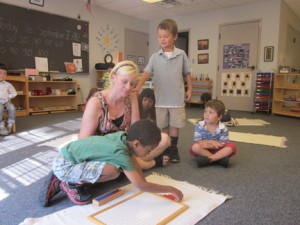By Bart Theriot, Head of School, Administration
The earliest lessons learned by students new to the Montessori environment are those of grace and courtesy. As discussed in Part I, these lessons form the backbone of the Montessori method. As the new year begins, it is always fun to see the children learning how to relate to one another as they begin to take responsibility for their own development. The wonderful thing about these lessons is that they continue through the child’s entire Montessori experience. They build the framework for the life ahead. We’re going to discuss as many as we can here on the MAB website. Today, let’s talk about patience –certainly, an essential human skill .
Does this scenario sound familiar? You’re having a conversation with your spouse –nothing time sensitive or important, just catching up on the day’s events. 45 seconds into your conversation, you hear “Mom.” Your beautiful child approaches and stands directly in between you and your spouse and says “MOM!” What happens next varies from house to house. Many parents will stop their conversation and direct their attention to the child. Some parents may attempt to continue their conversation and ignore the child –a tactic which is usually met with “Mom. Mom. Mooommmm. MOMMY!” until the parent has completely forgotten what she was talking about, thus ending the conversation all the same.
Patience comes in many forms. It is one thing to have patience when engaged in a preferred activity, but another thing entirely when waiting for a need to be met. Neither of the two options above provide the child with an opportunity to develop her patience. Simply ignoring the child may allow you to finish your conversation, but doing so does not send the proper message to the child, who may learn that ignoring is an acceptable method of human interaction. However, if the parent immediately gives her attention to the child, the message is sent that no matter what mom is doing, what the child wants is more important. In the grand scheme of things, our children’s needs must come first. The problem arises when neither the parent nor the child is able to treat wants differently than needs. After all, when you are accustomed to having all your wants and needs met immediately, who needs to know the difference between the two?
Dr. Montessori clearly recognized the need for patience in early life. As a result, nearly every material in the classroom and all of those in the practical life and sensorial sections teach patience. Here’s a lesson our teachers use from toddlers through elementary. Please try it at home and let us know how it goes (chances are your child has already heard it, but she will get a real kick out of doing it with you). It’s also a good way to show her that you are a part of her class.
The next time your child interrupts a conversation in this manner, use this as the opportunity to share this lesson with her. Pause your conversation, get down to her level and while making eye contact, say “I am talking to dad right now. I want to hear what you have to say, but I will listen to you when I am finished my conversation with dad. In the meantime, please put your hand on my shoulder/arm and wait patiently until I stop talking and look at you.”
This may take a few times to get it right. After a few attempts, it is helpful to remind the child simply by quietly motioning to her to wait without making eye contact and softly tapping your hand on your shoulder to remind her what she should do. When your child has mastered this technique, you can explain to her that she may simply wait nearby as the hand on your shoulder is no longer necessary.
There is also a nice little bonus lesson of independence attached to this. It happens without any extra effort on the part of the adult, but we see it very often in our elementary classroom. In addition to developing patience, your child will also begin to learn to find the answer to her own questions. Then all that is left is to learn to differentiate needs and wants, but that’s another lesson for another time.





